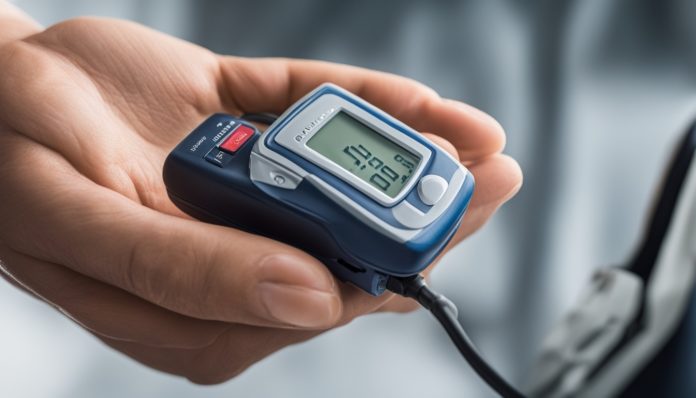Did you know about 30% of people with Type 2 Diabetes (T2D) could manage their sugar levels better with an insulin pump? This shows how much advanced insulin pump technology can help in controlling diabetes. With more people getting T2D, mainly due to obesity, it’s important to know how insulin pumps work.
Insulin pumps give insulin straight under the skin all day. This method is steadier and more controlled than taking many shots every day. By working together with Continuous Glucose Monitoring (CGM) systems, these pumps let users watch their sugar levels in real time. They can then adjust their insulin as needed. This advance has changed how people with T2D handle their disease, and it could improve their health over time.
Key Takeaways
- An insulin pump can lead to significantly better glycemic control for Type 2 Diabetes patients.
- Approximately 30% of T2D patients could benefit from switching to advanced insulin pump technology.
- Continuous Glucose Monitoring systems enhance insulin pump efficacy by providing real-time glucose data.
- Insulin pumps offer a more consistent insulin release compared to multiple daily injections.
- Proper management with an insulin pump may lead to long-term health benefits.
Introduction to Insulin Pumps and Type 2 Diabetes
Insulin pumps have become more popular for managing type 2 diabetes. These devices provide constant insulin in a way that’s similar to the body’s natural insulin release. They offer great benefits for people with diabetes.

What is an Insulin Pump?
An insulin pump is a device that gives insulin to people with diabetes. It delivers insulin smoothly through a tube under the skin. This helps keep blood sugar stable. Studies show insulin pumps work better than multiple daily injections for controlling type 2 diabetes.
Understanding Type 2 Diabetes
Type 2 diabetes is a long-term condition where the body struggles with insulin use. It differs from type 1 diabetes because it’s about resistance to insulin, not an immune attack. Keeping blood sugar levels in check is essential.
Starting insulin early and using tools like insulin pumps are key. They help save the beta cells that make insulin. Research supports the use of insulin pumps. They can slow the disease’s progress and improve health.
Advantages of Using an Insulin Pump for Type 2 Diabetes
Using an insulin pump therapy for type 2 diabetes has big benefits. It gives a steady and precise insulin amount unlike injections. This leads to stable blood sugar levels.

Insulin pumps reduce the risk of very low blood sugar. They adjust insulin levels by checking glucose all the time. This decreases the chance of severe hypoglycemic episodes.
Insulin pumps also offer more freedom in lifestyle choices. People can better manage when and what they eat. This can make life with diabetes easier and happier.
Insulin pump therapy for type 2 diabetes also improves long-term glucose control. Studies show better hemoglobin A1c levels, leading to fewer diabetes complications.
Lastly, insulin pumps make taking insulin simpler. They automate insulin delivery, cutting down on injections. This makes managing diabetes daily less of a hassle.
Comparison: Insulin Pumps vs. Multiple Daily Injections
Understanding the differences between using an insulin pump and insulin injections is key for those managing type 2 diabetes. It’s crucial to know how each method affects your daily life and health. This section explores the effectiveness and convenience of both, giving you a clear view.
Effectiveness
Studies show that insulin pumps often work better than multiple daily injections (MDI) for controlling blood sugar. They can lower HbA1c levels more effectively and cause fewer low blood sugar incidents. This is because the pump gives a steady flow of insulin, allowing for precise adjustments all day.
Users of insulin pumps usually see more stable blood sugar levels and manage their diabetes better. On the other hand, multiple daily injections involve many needle pricks each day, which might not always keep blood sugar at the desired level. Although many people do well on MDI, it doesn’t offer the same level of control as pumps, possibly leading to more ups and downs in blood sugar.
Convenience and Lifestyle
Insulin pumps are not just about medical benefits; they also offer lifestyle advantages. They are more hidden, which is great for people with active lives. You can wear a pump under your clothes without anyone noticing, making it easier to handle diabetes without feeling judged.
With a pump, you can adjust your insulin for meals with just a button press, avoiding the need for many injections. This convenience can make it easier to stick with your treatment plan. The hassle and discomfort of needles are much less with pumps.
In contrast, multiple daily injections can disrupt your day and make you carry around pens and needles. Finding a private place for injections can be tough in public or at work. Managing diabetes can feel more complicated with injections.
| Aspect | Insulin Pumps | Multiple Daily Injections (MDI) |
|---|---|---|
| Effectiveness in Glycemic Control | Lower HbA1c, fewer hypoglycemic episodes | Effective but less precise |
| Convenience | Discreet, easier dosing | Requires multiple daily pricks |
| Lifestyle Compatibility | More adaptable, less social stigma | Invasive, can be less practical in public or workplaces |
How Insulin Pumps Work to Manage Blood Sugar Levels
Insulin pumps are a big help for people with Type 2 Diabetes. They help keep blood sugar levels even. This means fewer highs and lows in sugar levels.
Continuous Subcutaneous Insulin Infusion
Insulin pumps work by giving insulin all day and night. This method is called continuous subcutaneous insulin infusion (CSII). It helps keep blood sugar levels steady.
By doing this, CSII makes sure glucose levels are more consistent. People using it have fewer sudden drops in their sugar levels. It’s a safer way than older methods.
Sensing and Adjusting Glucose Levels
Today’s insulin pumps can adjust sugar levels by themselves. They work with Continuous Glucose Monitoring (CGM) systems. This shows current sugar trends.
The pump changes insulin delivery based on real-time needs. It helps keep sugar levels right where they need to be. This gives users more control without constant worry.
Criteria for Selecting the Best Insulin Pump for Type 2 Diabetes
Choosing the right insulin pump for type 2 diabetes is important. Consider various insulin pump features carefully. The choice should be based on patient needs and what healthcare providers recommend.
Features to Consider
When looking at insulin pump features, focus on key aspects:
- Continuous Glucose Monitoring (CGM) Integration: This ensures the best monitoring of glucose levels.
- User-Friendliness: The pumps are easy to use with an intuitive interface.
- Accuracy of Delivery: They deliver insulin precisely.
- Battery Life: The batteries last a long time for ongoing use.
- Waterproof Features: They can resist water, allowing for more flexibility in everyday tasks.
Popular Models and Brands
There are several top insulin pump brands known for their reliability and unique features:
| Brand | Model | Key Features |
|---|---|---|
| Medtronic | MiniMed Series | Advanced CGM integration, Touchscreen, Waterproof. |
| Tandem Diabetes Care | t:slim X2 | Remote bolusing, User-friendly interface, Long battery life. |
| Insulet Corporation | Omnipod | Tubeless design, Waterproof, Various infusion set options. |
By considering these insulin pump features, patients and doctors can find the best insulin pump. Popular options include Medtronic’s MiniMed, Tandem’s t:slim X2, and Insulet’s Omnipod. They ensure excellent diabetes management.
The Role of Continuous Glucose Monitoring in Insulin Pump Therapy
Continuous glucose monitoring, or CGM, is key in insulin pump therapy for type 2 diabetes. It gives real-time info on blood sugar levels. This helps patients control their glucose better and plan for changes.
This lowers the chances and effects of low blood sugar. It makes life better overall.
CGM and insulin pumps work together to smartly adjust insulin. They match insulin doses closely to what the patient needs. This is great for busy people or anyone who finds it hard to spot low blood sugar signs.
CGM’s full data helps doctors make smarter choices. This tech helps patients and doctors work together for better health results. For more on CGM in insulin pumps, check out UMass Medical School’s diabetes education page.
Challenges and Limitations of Insulin Pump Therapy for Type 2 Diabetes
Insulin pump therapy has many benefits, but it also comes with challenges. These include medical and financial issues. They influence patients’ choices and who can get this treatment.
Potential Risks and Side Effects
Using an insulin pump may cause skin problems or infections. This happens because the pump stays on the skin all the time. If not handled properly, it can also lead to infections. Another issue is the pump might not work right, messing up insulin delivery. These problems need careful attention to keep the therapy effective.
Cost and Accessibility
Many people find insulin pump therapy too expensive. Insulin pump costs cover buying the pump and the money spent on items like infusion sets and CGM sensors later on. Insurance is important here. Unfortunately, for some, their insurance doesn’t fully support access to insulin pumps, making it hard for people without good insurance to get this treatment.
| Aspect | Details |
|---|---|
| Device Cost | $4,500 – $6,500 |
| Annual Supply Cost | $1,000 – $2,500 |
| Insurance Coverage | Varies by provider and plan |
Patient Experiences and Satisfaction with Insulin Pump Therapy
People using insulin pumps are often very happy with them. They find that their lives improve a lot compared to when they took many shots every day. Insulin pumps help people feel more free and flexible in controlling their diabetes.
One big plus of using an insulin pump is how convenient it is. Instead of many shots, the pump gives insulin under the skin all day and night. This helps control blood sugar better and is less of a bother every day.
Yet, not everyone finds using an insulin pump easy at first. Getting used to having the pump on all the time can be tough. But, many find they get used to it and prefer it. They feel it’s an easier way to handle their Type 2 Diabetes than regular shots.
FAQ
What is an insulin pump?
An insulin pump is a small device that gives insulin to treat diabetes. It gives a steady flow of insulin, just like a healthy body does.
How does an insulin pump work to manage blood sugar levels?
An insulin pump controls blood sugar by giving a constant insulin flow. This method keeps sugar levels stable and reduces low sugar risks.
What are the main benefits of using an insulin pump for type 2 diabetes?
Key benefits include better insulin control and more freedom in daily life. Users also see fewer low sugar events and better blood sugar levels. Overall, people find the treatment more satisfying.
How does an insulin pump compare to multiple daily injections (MDI)?
Studies show that pumps work better than injections in lowering sugar levels. Pumps are more private and easier to use, leading to better treatment results.
What features should be considered when selecting the best insulin pump?
Look for how it works with CGM, ease of use, delivery accuracy, battery life, and if it’s waterproof. Known options include Medtronic’s MiniMed, Tandem’s t:slim X2, and Insulet’s Omnipod.
What role does Continuous Glucose Monitoring (CGM) play in insulin pump therapy?
CGM tracks blood sugar in real-time, helping achieve tighter control. It can also adjust insulin delivery when used with pumps, enhancing outcomes and convenience.
Are there any risks or side effects associated with insulin pump therapy?
Possible risks include infections at the insertion site and skin issues. Keeping up with pump maintenance can lower these risks.
What are the costs associated with insulin pump therapy?
The therapy can be expensive, making it hard for some to afford, especially without good insurance. It also requires money for CGM sensors and other supplies.
How satisfied are patients with insulin pump therapy?
Many people are very happy with pump therapy. They enjoy a better life quality and the ease of not injecting all the time. Though experiences can differ, the convenience is a big plus for many.


